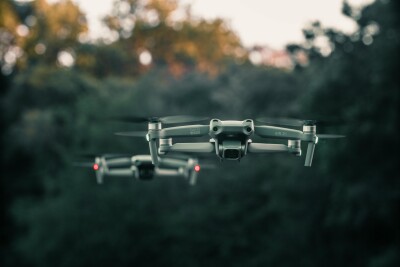We’ve all seen and heard about how artificial intelligence (AI) and machine learning are going to change everything from the way we travel to the way we watch TV and movies. However, the commercial applications of the technology could be even more revolutionary because they could completely redefine how entire industries approach individual tasks and entire projects.
While machine learning is actually a subset of AI, the two go hand in hand when it comes to utilizing computer systems to perform a specific task related to the inspection of infrastructure assets or increasing QA process productivity without specified instructions for doing so. Those are the types of tasks that are of specific interest to stakeholders in industries that range from energy to manufacturing to transportation.
KEEN-AI has been able to utilize these capabilities to make a quantifiable impact in both of these areas. Their platform continually learns from actions taken by human experts whilst they are working on task or project. Doing so has the potential to increase process productivity by 50% and reduce inspection time by 66%. These results are just the beginning of how and where AI and machine learning will define the way inspections and other established industrial processes could be improved and augmented.
Objectives Before Engineering
Many companies want to apply AI and machine learning to established processes that are using images or video in order to improve them, and this approach represents one of the biggest challenges with successful adoption. Stakeholders often get excited about the possibilities associated with the technology and ask to have them applied to something they’re already doing, but that approach puts the technology before the business, which can lead to poor results.
“To do this properly, what we need to do is look at what someone is actually trying to do and identify what needs to be changed to make it more amenable to machine learning,” said Amjad Karim, Founder & CEO at KEEN AI. “That might mean a change in process because there are things that are easier to enable in process than they are in technology. And vice versa. We get our customers to think about the objective first, and then engineer the process to work.”
Just trying to do "machine learning" as an object or goal isn't really effective. It’s why the KEEN-AI team asks not only how they can make a process amenable to machine learning and machine vision, but will also quickly develop a proof of concept and prototype to show how it might work. These models are built to scale, but they’re ultimately looking at the business problem first, and not just engineering a technical solution.
Understanding what it would mean to develop a solution that incorporates AI and machine learning capabilities to address a specific problem is essential. What is the underlying problem that needs to be solved? How can AI make it better? In many cases, deep-learning models can be applied but if doing so doesn’t help the business in any real way in terms of the bottom line or some other measurable, then there's no point in doing it.
“People quite often get excited about a technology and want to do it, but we have to ask them why they really want to do something,” said Mubin Khan, Marketing Director of KEEN AI. “There are many ways you can apply this technology. Maybe you've already got lots of footage and lots of processes, but how do you choose the right pictures? That can lead to a discussion about something that hadn’t been considered, or adjusting a process that someone initially thought was too difficult or simple to change, but will enable a defined benefit.”
It’s easy to get caught up in the limitless future of the technology, and that can sometimes come at the expense of what needs to be defined in the present. At every stage, some sort of benefit needs to be unlocked. KEEN AI has shown what it means to create those benefits in a very real way for companies that are using video for inspection purposes and for ones concerned with quality control. What’s essential to realize is that doing so isn’t as much about automation as it is augmentation.
 What's Really Doable Today? And How Can We Do It?
What's Really Doable Today? And How Can We Do It?
The chasm between what’s real and what will eventually be possible with AI and machine learning is a challenge that many organizations struggle to work through. It’s why that even if it’s initially small, KEEN AI is focused on enabling some benefit to deploy their models in the present. Doing so has to tangibly make a process easier or save money or unlock some insight that previously wasn’t available.
The KEEN AI platform is designed to help companies develop their own models and deploy them through APIs or condition assessment web applications. Their goal is to enable people to do things themselves very quickly but still set the right expectations around what can be accomplished today and in the future.
“One of the things we do is to help people understand what can and can't be accomplished,” Karim told Commercial UAV News. “There are some great stories out there about how this technology can make a difference and people get excited about applications like self-driving cars, but we're really good at pulling people back to help them understand what's really doable today. How can we deploy our deep learning models right now? And what kind of an impact will doing so enable?”
Consider how this kind of machine learning model could impact an inspection process that presently involves operators watching footage to look for defects or other issues. If a model that can automatically identify potential defects or trouble spots, those operators don’t have to spend their time on assets that don’t need their attention which frees them up for other tasks. Operators will then only need to look at items of interest, and the application to identify these items will only get better and better.
Applications that can automatically identify key components of a piece of infrastructure and present those components to the operator for review are a reality today, and that model is a perfect example of what the KEEN AI team means when they talk about augmentation versus automation. Some processes can be automated, but their solutions are more about augmentation. They’re trying to help people who are already focused on a particular process accomplish that task in a much quicker or more reliable manner.
To illustrate this concept, Karim mentioned what happened when IBM’s Deep Blue defeated Garry Kasparov in chess. Many believed it meant that from that point forward, computers would always be the best chess players, but that didn’t turn out to be the reality. As it turns out, the best chess player is a human augmented by a machine to work together, and it’s something Kasparov himself has championed. The combination of human intuition with a computer’s ability to quickly search large datasets makes the team greater than the sum of its parts.
AI and machine learning models can enable these combinations for any organization that is looking to inspect large pieces of infrastructure like railroads or bridges, or have large video datasets that aren’t being utilized right now. It can be difficult to balance out that reality with the eventual possibilities though, so what’s the best place to begin?
“A good first step is to think about where you have a visual inspection process,” said Karim. “Are you currently utilizing a process where you use your eyes to review video or imagery? If you’re looking at the same type of thing over and over, you’re looking at different components, but the process is the same. So you have to ask, could there be efficiencies gained by having part of that process augmented or automated? Could you imagine using a computer to do this task? Or help with it?”
That question has led to efficiencies many organizations have been able to quantify in terms of their bottom line today, while also opening up the potential of even greater efficiencies in the future. It’s a concept that gets back to the augmentation of various processes that KEEN AI is so focused on, which will ensure that performing a task in a faster, cheaper or safer way is something that individual operators and entire organizations can benefit from.
To learn more about how KEEN AI can deliver a proof of concept or prototype within 7 weeks, click here or connect with them at Commercial UAV Expo Europe.




.png.small.400x400.png)











Comments